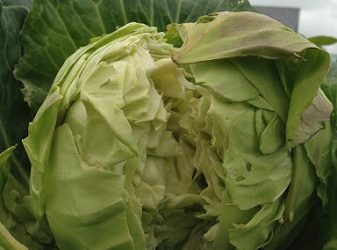Causes of watery spots in cabbages.

Cabbage is one of the most profitable vegetables if one grows them at the right time; that is when demand is high.
However, despite the good prospects for the vegetable, one of the diseases that affect the crop, thus hurting farmers’ earnings, is soft rot.
Affected crops normally develop water-soaked spots, which enlarge over time and become sunken and soft. The tissues beneath the spots start to wilt and become mushy and discolored.
The spots on the leaves appear cream to black in colour. In instances of heavy infestation, rotting of leaves, stems and roots accompanied by a smelly odor starts. Internally, the cabbage veins start blackening, eventually rotting during storage.
The disease is caused by the bacteria Pectobacterium carotovorum. It enters the crop through wounds caused by insects, tools when working on the farm or through natural openings.
It is spread from one plant to another by insects, contaminated tools and water. Movement of infected plant debris or the soil and species of maggot flies can also spread disease.
The disease normally spreads very fast during the rainy season or while carrying out overhead irrigation. Warm temperatures and humid conditions also favor attack.
Crop Rotation
The bacteria normally survives in the soil and on plant debris. Therefore, you must carry out crop rotation.
Calcium deficiency in the soil and wet weather promote rapid bacterial multiplication of the disease.
Apart from cabbages, the disease affects other brassica family crops like lettuce, sukuma wiki (collard greens) and cauliflowers.
The disease can be prevented by ensuring plants get good air circulation and plenty of sun through good spacing.
For cabbages, the correct spacing is 40 by 60cm depending on the variety. It’s ideal to plant using DAP as this promotes rapid crop establishment.
Topdressing should be done using CAN to promote vegetative growth. Well-rotten manure should also be used as it contains high urea content.
Weeding should be done either by the use of hands or herbicides as it promotes faster drying of the crop after raining.
Mulching is vital as this prevents splash erosion on the plants during the heavy rainfall.
Overhead irrigation such as the use of the sprinklers should be avoided in cabbages, broccoli and cauliflower after head formation.
Morning watering can aid in controlling disease infestation as the leaves usually dry, unlike in the evening.


